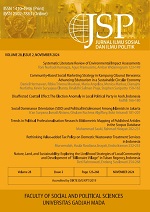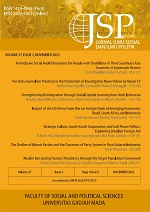Does Democracy Reduce Corruption in Indonesia?
Azwar Azwar(1*), Achmat Subekan(2)
(1) Sekolah Tinggi Ilmu Islam dan Bahasa Arab (STIBA) Makassar, Indonesia
(2) Financial Education and Training Agency, Ministry of Finance, Indonesia
(*) Corresponding Author
Abstract
This study aims to analyze the long and short-run impact of democracy on corruption in Indonesia. This study used the method of Autoregressive Distributed Lag (ARDL) and dynamic Error Correction Model (ECM) technique during the year of 1995-2020 with secondary data from The Economist Intelligence Unit (EIU), The Global Economy and World Bank’s World Development Indicators (WDI), and Transparency International. The results of the study indicated that democracy has significant effects on the level of corruption only in the long run. In the long run, the results show that the impact of democracy is significant at a 1% significance level and decreases the amount of corruption in Indonesia. A 1% change in democracy and other factors are considered equal, which will change the corruption level by approximately 0.2%. The results imply that political stability associated with democracy will result in the corruption index. In other words, the results suggest that democracy reduces corruption. From a policy point of view, this means that developing democratic institutions should be part of strategies to reduce corruption.
Keywords
Full Text:
PDFReferences
Ades, A., & Di Tella, R. (1999). Rents, competition, and corruption. American Economic Review, 89(4), 982–993. Retrieved from https://www.jstor.org/stable/117169.
Bahtiar, R. A. (2020). Democracy and Corruption in Indonesia (A Study of Corruption Cases in Reformation Era). Third International Conference on Social Transformation, Community and Sustainable Development (ICSTCSD 2019), 73–77. https://dx.doi. org/10.2991/icstcsd-19.2020.30.
Brueckner, M. (2021). Democracy and Corruption. Journal of Risk and Financial Management, 14(10), 492. https://doi. org/10.3390/jrfm14100492.
Coppedge, M. (2002). Democracy and dimensions: Comments on Munck and Verkuilen. Comparative Political Studies, 35(1), 35–39. https://doi.org/10.1177%2F001041400203500102.
Dickey, D., & A Fuller, W. (1981). The Likelihood Ratio Statistics For Autoregressive Time Series With a Unit Root. In Econometrica (Vol. 49). https://doi.org/10.2307/1912517.
Ferrin, M. (2016). An empirical assessment of satisfaction with democracy. How Europeans View and Evaluate Democracy, 283–306. https://doi.org/ 10.1093/acprof:oso/9780198766902.003.0013.
Fjeld e, H., & Hegre, H. (2014). Politic al corruption and institutional stability. Studies in Comparative International Development, 49(3), 267–299. https://doi. org/10.1007/s12116-014-9155-1.
Gupta, S., De Mello, L., & Sharan, R. (2001). Corruption and military spending. European Journal of Political Economy, 17(4), 749–777. https://doi.org/10.1016/S0176-2680(01)00054-4.
Johansen, S., & Juselius, K. (1990). Maximum likelihood estimation and inference on cointegration—with appucations to the demand for money. Oxford Bulletin of Economics and Statistics, 52(2), 169–210. https://doi.org/10.1111/j.1468-0084.1990.mp52002003.x.
John, W. C. (2013). Research Design Pendekatan Kualitatif, Kuantitatif dan M ixed. Yogyakarta: Pustaka Pelajar. Retrieved from https://openlibrary.telkomuniversity. ac.id/pustaka/14172/%20research-design- pendekatan-kualitatif-kuantitatif-dan- mixed-3-e-.html.
Johnston, M. (1996). The search for definitions: the vitality of politics and the issue of corruption. International Social Science Journal, 48(149), 321–335. https://doi. org/10.1111/1468-2451.00035.
Kalenborn, C., & Lessmann, C. (2013). The impact of democracy and press freedom on corruption: Conditionality matters. Journal of Policy Modeling, 35(6), 857–886. https:// doi.org/10.1016/j.jpolmod.2013.02.009.
Li, H., Xu, L. C., & Zou, H. (2000). Corruption, income distribut ion, and growt h. Economics & Politics, 12(2), 155–182. Retrieved from http://down.aefweb.net/ WorkingPapers/w472.pdf.
Lipset, S. M. (1998). George Washington and the founding of democracy. Journal of Democracy, 9(4), 24–38. https://doi. org/10.1353/jod.1998.0066.
Mauro , P. (1998). Corruption and the composition of government expenditure. Journal of Public Economics, 69(2), 263–279. https://doi.org/10.1016/S0047-2727(98)00025-5.
McMann, K. M., Seim, B., Teorell, J., & Lindberg, S. I. (2017). Democracy and Corruption: A Global Time-Series Analysis with V-Dem Data. V-Dem Working Paper, 43. https:// dx.doi.org/10.2139/ssrn.2941979.
Merkel, W. (2014). Is there a crisis of democracy?Democratic Theory 1 (2): 11–25. Available at: Retrieved on 14 July 2016. Retrieved from https://www.researchgate.net/ publication/269906448_Is_there_a_crisis_ of_democracy_Can_we_answer_the_ question.
Mietzner, M. (2013). Money, power, and ideology:Political parties in post-authoritar ian Indonesia. NUS press. Retriev ed from https://www.researchgate.net/ publication/290874151_Money_power_ and_ideology_political_parties_in_post- authoritarian_Indonesia.
Mohtadi, H., & Roe, T. L. (2003). Democracy, rent seeking, public spending and growth. Journal of Public Economics, 87 (3–4), 445–466. https://doi.org/10.1016/S0047-2727(01)00135-9.
Montinola, G. R., & Jackman, R. W. (2002).Sources of corruption: A cross-country study. British Journal of Political Science, 32(1), 147–170. https://doi.org/10.1017/S0007123402000066.
Myerson, R. B. (1993). Effectiveness of electoral systems for reducing gov ernment corruption: a game-theoretic analysis. Games and Economic Behavior, 5(1), 118–132. https://doi.org/10.1006/game.1993.1006.
Pesaran, M. H., & Shin, Y. (1995). An autoregressive distributed lag modelling approach to cointegration analysis. Retrieved from https://citeseerx.ist.psu.edu/viewdoc/do wnload?doi=10.1.1.153.3246&rep=rep1& type=pdf.
Pesaran, M. H., Shin, Y., & Smith, R. J. (2001). Bounds testing approaches to the analysis of level relationships. Journal of Applied Econometrics, 16(3), 289–326. https://doi. org/10.1002/jae.616.
Phillips, P., & Perron, P. (1986). Testing for a Unit Root in Time Series Regression. In Cowles Foundation, Yale University, Cowles Foundation Discussion Papers (Vol. 75). https://doi.org/10.2307/2336182.
Robertson-Snape, F. (1999). Corruption, collusion and nepotism in Indonesia. Third World Quarterly, 20(3), 589–602. https://doi.org/10.1080/01436599913703.
Rothstein, B. (2014). Human well-being and the lost relevance of political science . Retrieved from https://cadmus.eui.eu/bitstream/handle/1814/31262/MWP_LS_ Rothstein_2014_03.pdf?sequence=1.
Rowley, C. K., & Schneider, F. (2 008). Readings in public choice and constitutional political economy. Springer. https://doi. org/10.1007/978-0-387-75870-1.
Shabbir, G. (2017). Corruption, Democracy And Economic Growth. Pakistan Economic and Social Review , 55 (1), 127–145. Retrieved from https://www.jstor.org/ stable/26730216.
Sung, H.-E. (2004). Democracy and political corruption: A cross-national comparison. Crime, Law and Social Change , 41(2), 179–193. http://dx.doi.org/10.1023/B:CRIS.0000016225.75792.02.
Svensson, J. (2005). Eight questions about corruption. Journal of Economic Perspectives, 19(3), 19–42. https://doi.org/10.1257/089533005774357860.
Taghizadeh Elyas Abad, H., Rezazadeh, A.,& jahangiri, khalil. (2021). Study of the Impact of Democracy and Corruption on Foreign Direct Investment in West and East Asian Countries TT - ریثأت یسررب یجراخ میقتسم یراذگ هیامرس بذج رب داسف و یسارکومد
ایسآ قرش و برغ یاهروشک رد. MDRSJRNS, 21(3), 109–144. Retrieved from http://ecor. modares.ac.ir/article-18-47984-en.html
Treisman, D. (2007). What have we learned about the causes of corruption from ten years of cross-national empirical research? Annu. Rev. Polit. Sci., 10, 211–244. http://dx.doi.org/10.1146/annurev.polisci.10.081205.095418.
Ur Rehm an, I., & Shahbaz, M . (2014). Multivariate-based Granger causality between financial deepening and poverty: the case of Pakistan. In Quality & Quantity (Vol. 48). https://doi.org/10.1007/s11135-013-9952-z
Uslaner, E. M., & Rothstein, B. (2016). The historical roots of corruption: State building, economic inequality, and mass education. Comparative Politics, 48(2), 227–248. http://dx.doi.org/10.5129/001041516817037736.
Wei, S.-J. (2000). How taxing is corruption on international investors? Review of Economics and Statistics, 82(1), 1–11. Retrieved from https://www.jstor.org/ stable/2646667.
Article Metrics
Refbacks
- There are currently no refbacks.
Copyright (c) 2022 Jurnal Ilmu Sosial dan Ilmu Politik

This work is licensed under a Creative Commons Attribution-NonCommercial-NoDerivatives 4.0 International License.























